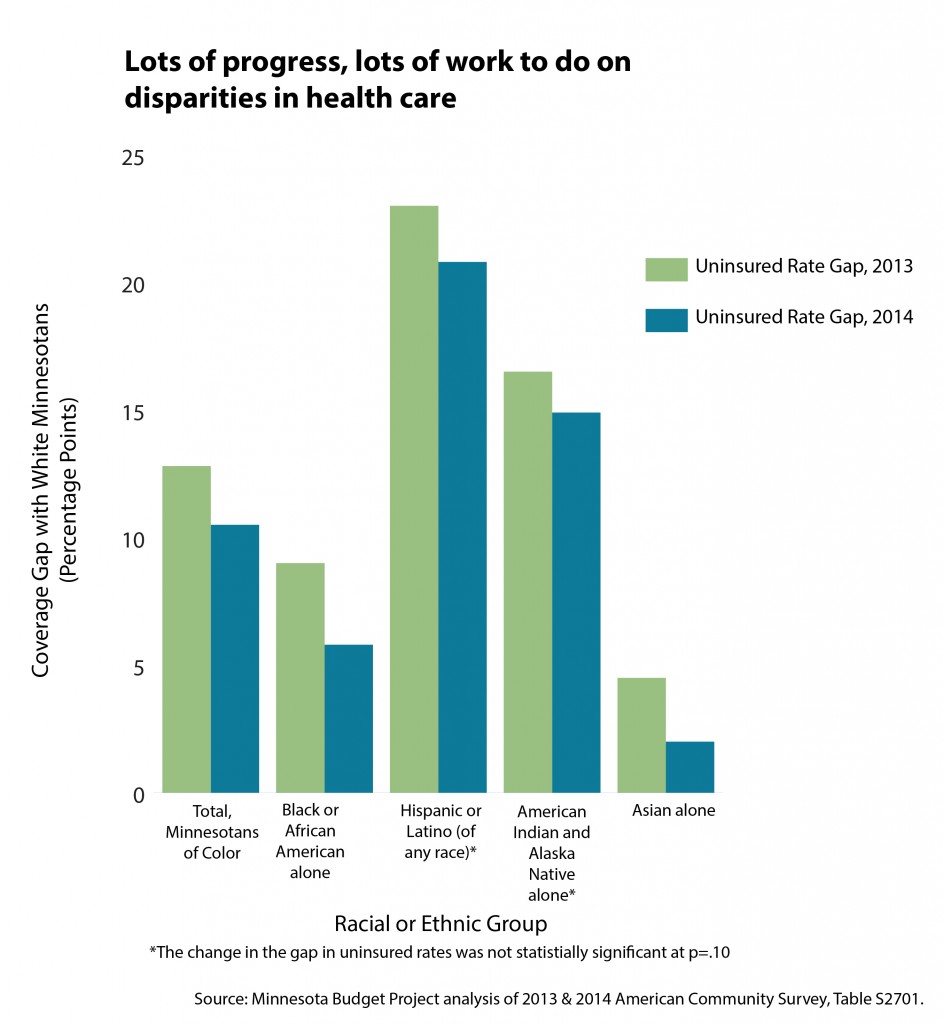Health insurance is a basic necessity — and if you don’t have it, Minnesota’s nation-leading health care system might as well be an ocean away. Significant disparities in the health insurance coverage rates of different racial and ethnic groups in Minnesota mean that a large number of our neighbors struggle to get the health care they need for themselves and their families. Fortunately, that gap is shrinking due to smart public investments.
In 2013, the health care uninsured rate — or the percent of people without health insurance — was nearly 20 percent for Minnesotans of color. That was about 13 percentage points higher than the uninsured rate of their white neighbors.
Then, in 2014, the Affordable Care Act (ACA) rolled out in full. Minnesota took advantage of many of the ACA’s provisions that made health insurance more affordable and accessible. The number of uninsured black or Asian Minnesotans tumbled by close to a third. Overall, the uninsured rate for Minnesotans of color fell by 4.3 percentage points. In addition, the uninsured rates of white Minnesotans decreased by 1.9 percentage points.
In other words, most Minnesotans had an easier time getting health insurance, but the policy changes were particularly important in certain communities of color. As the chart below demonstrates, the coverage gap – the gap between the uninsured rates of white and non-white Minnesotans – shrank by 2.3 percentage points between 2013 and 2014.

Our work is far from done. As a recent report from Minnesota’s Department of Health points out, Minnesotans of color and Native Americans are still two to three times as likely to lack health insurance compared to white Minnesotans. The uninsured rate for our Native American and Hispanic neighbors remains disturbingly high, and we can’t even tell for certain whether the coverage gaps for these communities increased or decreased from 2013 to 2014 because the survey’s sample size in those communities was too small.
How do we get closer to ending disparities in the uninsured rate? We could start by making MinnesotaCare an option for more Minnesotans. MinnesotaCare is an affordable, public health insurance option with sliding-scale premiums, primarily used by working adults.
Policymakers, health care industry leaders and advocates who served on the Governor’s Health Care Finance Task Force, recently proposed two MinnesotaCare improvements that would likely make a further dent in uninsured rate disparities. First, they recommended providing access to MinnesotaCare for undocumented immigrants, a group of 95,000 Minnesotans that lack affordable coverage options despite playing vital roles in our economy and our communities.
Second, they recommended increasing the amount people can earn and still qualify for MinnesotaCare, which could significantly benefit people of color, who are less likely to have access to an affordable insurance option through their employers.
Policymakers are having important discussions about ending racial disparities in Minnesota. This conversation must result in bold policy solutions if we are going to move in the right direction. Thanks to smart public investments, the color of a Minnesotan’s skin has become less of a factor in determining access to the nation’s best health care system. If we keep strengthening those investments, we can get even closer.